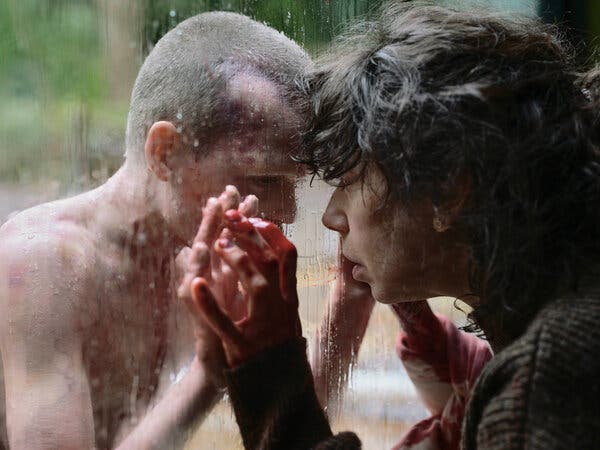A24’s latest horror offering, Bring Her Back, marks a bold continuation for the Philippou brothers, Danny and Michael, whose previous film, Talk to Me, garnered significant acclaim, becoming the highest-grossing A24 horror movie to date. The new release plunges deeper into the grim realities of loss and grief contrasted against the backdrop of supernatural horror, presenting audiences with a visceral experience that compels both reflection and dread.
From Viral Horror to Domestic Terror
The Philippou twins showcased their talents with their engaging debut Talk to Me, a film explored the horrors of a viral parlor game gone horribly wrong. Their follow-up, Bring Her Back, however, shifts focus to the psychological and domestic landscape of horror, as they tell the story of Laura, played hauntingly by Sally Hawkins. The film tackles the complexities of grief and the sometimes perilous lengths individuals go to for love, particularly in the wake of profound loss.
In Bring Her Back, Laura, a grieving mother, takes in two siblings, Piper and Andy, soon after the death of her own daughter. The movie presents a tale that deftly merges the domestic thriller and horror genres, turning the familiar trope of the protective mother figure on its head. As Laura attempts to recreate her family, her methods grow increasingly sinister, creating an unsettling environment fraught with tension and dread.
The Artistic Tension of Horror and Humanity
Critics have drawn attention to the movie’s lingering sense of unease and its visuals, which masterfully blend horror with psychological depth. While the specter of Laura’s intense grief looms over every frame, parallels to her children’s turmoil amplify the horror experienced by her wards. Each character primarily serves to expose not just the fragility of childhood, but also the devastation that stems from unaddressed trauma.
Hawkins’ performance as Laura is particularly mesmerizing. The duality of her character—a nurturing figure on one hand, and a malevolent force on the other—serves to amplify the film’s central themes. Critics noted: “Hawkins plays Laura’s cheery psychopathy and cunning cruelties with precision,” allowing the audience to question which side of the mother they are viewing at any given moment. Her relationship with Andy and Piper is anything but straightforward, weaving a complex web of caretaker trauma that underlies their story.
The contrast between Laura’s tender moments with Piper and her cruel gaslighting toward Andy illustrates the film’s emotional depth, pushing audiences to grapple with the ambiguity of grief—a theme deeply explored throughout the film. The screenplay reveals how Laura’s experiences shape her actions, leading audiences to questions about morality in grief-infused scenarios.
Unearthing Themes of Abuse and Psychological Complexity
A pivotal aspect of Bring Her Back is its exploration of domestic abuse within the context of the supernatural. Critics have lauded the film for effectively positioning horror within the real-world implications of familial dysfunction. The unsettling interactions between Laura and the siblings reveal a troubling dynamic, rooted in loss, desperation, and mental health issues.
Observers have posited that Laura’s behavior, while extreme, captures the reality for many experiencing profound sorrow and regret. The film powerfully questions whether grief can distort our understanding of love and belonging. For example, Laura’s obsession with resurrecting her deceased daughter reveals how grief can warp affection into something catastrophic.
Visual Aesthetics: Practical Effects and Cinematic Language
The visual composition of Bring Her Back is stunning, relying heavily on practical effects to elicit genuine fear rather than cheap jump scares. The cinematographic choices propel the audience into an immersive experience, using shadow and light to deepen the psychological intensity of Laura’s home—chaotic yet hauntingly familiar.

Each scene builds upon the last, constructing a sinister atmospheric pressure that mirrors Laura’s spiraling mental state. Visually, viewers are gifted a film that feels more like a fever dream than an exploration of conventional horror. Critics have noted that scenes featuring Oliver, the selectively mute child, amplify this unsettling nature through stark visuals that represent childhood cruelty and trauma at its core.
The Balance of Horror and Heart
As audiences are drawn deeper into Laura’s world, the creeping dread escalates, leading to an unsettling conclusion that challenges conventional horror tropes. The film raises questions about morality, family, and the price of love, blurring the lines between good and evil. Many critics have noted the movie’s ability to engage viewers with its psychological depth while simultaneously inflicting visceral horror, making it a unique narrative within the genre.
Ultimately, Bring Her Back showcases a maturity in the filmmaking craft of the Philippou brothers. The shift from youth-oriented horror in Talk to Me to delve into raw emotional themes in their sophomore work suggests growth and a clear intent to explore the darker sides of human experience. Critics argue that the film demands contemplation—both of its brutal reality and its deeper meanings, reflecting on how grief can shape behaviors in unexpected and disturbing ways.
As audience reactions continue to pour in, one can’t help but speculate about the impact of Bring Her Back on the horror landscape. With its unsettling messages, spiritually harrowing experiences, and outstanding performance by Hawkins, the film is poised to leave an indelible mark on both viewers and the genre itself.
A Journey into the Unfathomable
As the film invites us into the psyche of someone deeply affected by grief, Bring Her Back serves as a cautionary tale about the extents individuals may traverse in the grip of sorrow and desperation. While it may not provide all the answers about human trauma, its raw depiction of complex emotional landscapes makes it a standout addition to modern horror cinema. With significant performances, especially from Hawkins and the young cast, the film approaches familial love, loss, and the malignant aspects of grief through the lens of horror in a manner that is both thought-provoking and haunting.

